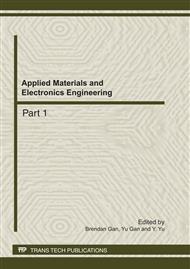[1]
L. Edelmann, R. Katzenbach, P. Amann, J. Weiss: Large-scale deformation tests on soil layers for landfills, Proc. of the 2nd Int. Congress on Environmental Geotechnics, Osaka, Japan, (1996), p.205–209.
Google Scholar
[2]
B.V.S. Viswanadham, K.V. Mahesh: Modelling deformation behaviour of clay liners in a small centrifuge, Canadian Geotechnical Journal Vol. 39 (2002), p.1406–1418.
DOI: 10.1139/t02-075
Google Scholar
[3]
C. Tang, B. Shi, W. Gao, F. Chen, Y. Cai: Strength and mechanical behaviour of short polypropylene fiber reinforced and cement stabilized clayey soil, Geotextiles and Geomembranes Vol. 25 N°3 (2007), p.194–202.
DOI: 10.1016/j.geotexmem.2006.11.002
Google Scholar
[4]
M.H. Maher, Y.C. Ho: Mechanical-properties of kaolinite fiber soil composite, Journal of Geotechnical and Geoenvironmental Engineering Vol. 129 N°2 (1994), pp.1381-1393.
DOI: 10.1061/(asce)0733-9410(1994)120:8(1381)
Google Scholar
[5]
C.N. Consoli, M.A. Vendruscolo, P.D.M. Prietto: Behavior of plate load tests on soil layers improved with cement and fiber, Journal of Geotechnical and Geoenvironmental Engineering Vol. 129 N°1 (2003), p.96–101.
DOI: 10.1061/(asce)1090-0241(2003)129:1(96)
Google Scholar
[6]
C.J. Miller, S. Rifai: Fiber reinforcement for waste containment soil liners, Journal of Environmental Engineering Vol. 130 N°8 (2004), p.981–985.
DOI: 10.1061/(asce)0733-9372(2004)130:8(891)
Google Scholar
[7]
O. Ple, H. Lê, P. Gotteland: A mechanical approach for fibre-reinforced clay in landfill caps cover application, European Journal of Environmental and Civil Engineering Vol. 13 N°1 (2009), p.53–69.
DOI: 10.1080/19648189.2009.9693085
Google Scholar
[8]
O. Ple, O. Bayard: Preliminary study of multiscale analysis in fibre reinforced concrete, Materials and Structures Vol. 35 N°249 (2002), p.279–284.
DOI: 10.1007/bf02482133
Google Scholar
[9]
S. Camp, J.P. Gourc, O. Ple, P. Villard: Mechanical behaviour of a clay layer for landfill caps cover application: experimental investigation and numerical modelling, theoretical and numerical unsaturated soil mechanics Springer Publishers Vol. 113 (2007).
DOI: 10.1007/3-540-69876-0_21
Google Scholar
[10]
S. Camp, O. Ple, J.P. Gourc: Proposed protocol for characterizing a clay layer subjected to bending, Geotechnical Testing Journal Vol. 32 N°3 (2009), p.273–279.
DOI: 10.1520/gtj101438
Google Scholar
[11]
S. Camp, J.P. Gourc, O. Ple: Landfill clay barrier subjected to cracking: Multi-scale analysis of bending tests, Applied Clay Science Vol. 48 N°3 (2010), p.384–392.
DOI: 10.1016/j.clay.2010.01.011
Google Scholar
[12]
G.P. Dall'Acqua: Fibre Reinforced Stabilized Soil, PhD Thesis, University of Birmingham (2000), United Kingdom.
Google Scholar
[13]
J.G. Zonberg, C. Li : Design of fiber-reinforced soil, 12th Panamerican Conf. of Soil Mechanics and Geotech. Engrg., Cambridge MA Vol. 2 (2003), p.2193–2200.
Google Scholar


